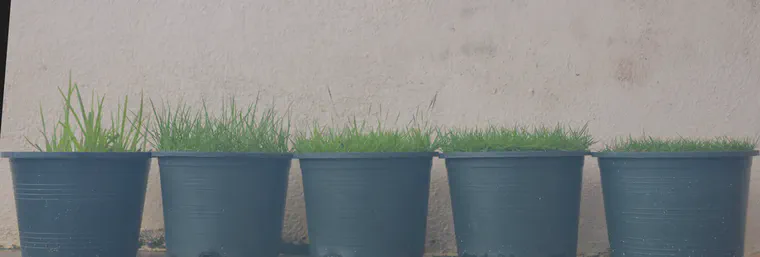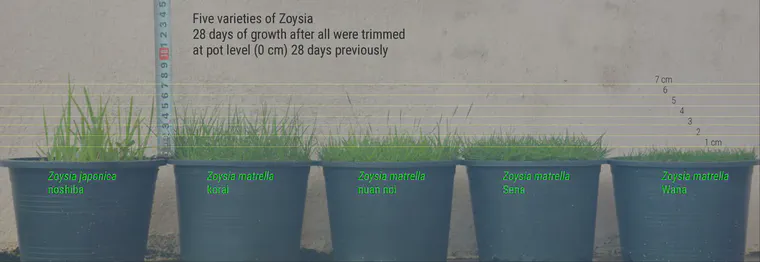Zoysia growth habit and the type I prefer (for golf)

It’s been cloudy, and raining, and I wasn’t in a rush to cut the grass. I decided to skip mowing for exactly 4 weeks to demonstrate the difference in growth habit that I wish everyone paid attention to. This is directed in some way at golf course architects, and golf course owners, and whoever is choosing a grass to use for golf courses in a tropical environment.
I lined up five different varieties of zoysia from left to right. There’s obviously a difference in mowing requirement here, and the differences in growth habit affect playability too. Click the image to bring it up to maximum size.

Noshiba is the standard rough grass in Japan. It has an upright growth habit. So does regular korai, which is the standard fairway grass in Japan. Those two grasses have decent cold tolerance, so they work well where there is a winter.
In Southeast Asia, varieties with a more prostrate growth habit (and presumably less cold tolerance) can be used, like the Thai korai (nuan noi), or even finer-bladed types like Sena or Wana. This happens to be a nuan noi fairway in the video below, and the prostrate growth habit of this variety allows for infrequent mowing and a surface on which one can play all kinds of shots.
The grasses that grow more upright are better for rough or lawns. The grasses that grow more horizontally are especially good at tee and fairway height, and the really slow-growing ones like Wana are great on greens.
I’ve been surprised to see so many courses planting the upright lawn-type zoysias when a prostrate type would give better playability. And I’ve seen the reverse, too, where a prostrate type is planted and expected to perform as rough.
You’ll also notice differences in seedhead production in those photos. That’s a story for another time.
The point I’d like to emphasize here is the substantial differences that exist in growth rate and growth habit (upright, intermediate, or prostrate) between zoysia varieties. Noshiba is about as coarse and upright as it gets, and you won’t find many more dwarf than Wana. But in between those extremes, there is a lot of diversity in how the grass will perform and how much maintenance it will require to produce the desired surface. And in places where the prostrate types survive the winter, the playability is much better than with the lawn types, and the mowing requirement is much lower to achieve that playability.